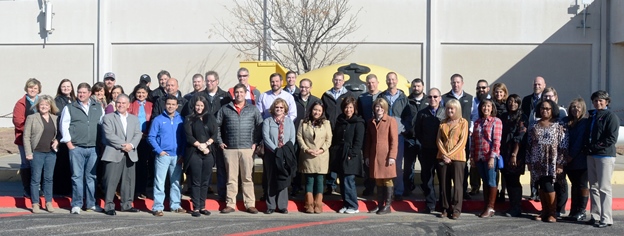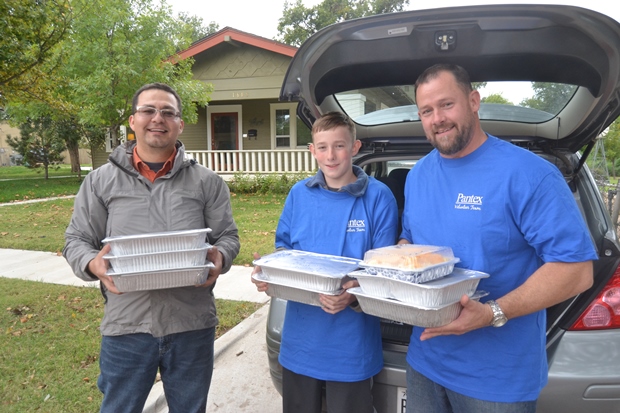Pantex Blog
Demystifying Pantex for Amarillo leaders
About 50 local business leaders made the second of their two annual trips out to Pantex recently, getting the chance to go tour the plant that remains a mystery for some many local residents.
The organization that arranged for the trip, Leadership Amarillo and Canyon, has been going strong for almost 40 years, providing tours of businesses and industries throughout the region for 10 months out of the year.

Amarillo and Canyon business leaders in front of a replica of the first atomic bomb, Fat Man.
They kicked off the tour hearing from Pantex Site Manager Michelle Reichert followed by the history of the plant by Interim Historian Monty Schoenhals. Then the group loaded up in their tour bus and drove over to a replica of the first atomic bomb, dubbed “Fat Man,” where they got a group picture.
Over lunch, those on the tour say being out here and seeing this first hand helps remove the cloud of mystery that seems to hang over Pantex for most residents.
Jeremy Roark, Director of Surgical services at Baptist St. Anthony’s Hospital says, “I get to put something physical with what you hear about in regard to Pantex. I overhear people talking about Pantex who come into BSA, and being here, gives us an association … it’s more of a reality than a mystery."
Technical Program coordinator for Amarillo College, Jerry Terry, agrees. “Being on the tour demystifies Pantex. It’s good to come out here and allows it to be something real for us.”
And if all goes according to plan, the next group of 50 new business leaders from the area should be touring their way through the front gate in about 6 months, excited to learn more about the plant.
CNS employees blaze through certification exam
CNS has made remarkable progress in fire protection this year with 17 CNS employees earning certified fire protection specialist credentials by passing the CFPS exam administered by the National Fire Protection Association.
The exam is designed to test candidates’ knowledge and proficiency in protecting facilities from fire and is based on the NFPA Fire Protection Handbook, which covers every aspect of fire protection. The certified employees work in various divisions of Mission Assurance; Mission Engineering; Safeguards, Security, and Emergency Services; the Uranium Processing Facility and Y-12 Operations.
“Ensuring a high level of fire protection for our sites is critical. One way we can do this is by providing our staff with opportunities for continuing education and training, as well as professional certification. By becoming certified, these employees have demonstrated their commitment to fire protection and CNS,” said Y-12 Fire Protection Engineering Manager David Greer. “We were fortunate to have the exam review course and test given on site.”
For 15 of the candidates, the exam was given at New Hope Center specifically to accommodate Y-12 and UPF project employees. Typically, candidates must travel to an authorized testing center, but CNS arranged to have the test given on site because of the large number of candidates. CNS also offered employees the opportunity to attend an on-site exam review class, as well as the fire protection engineering courses offered through the University of Tennessee program.
Austin Smith had wanted to take the exam for a long time and appreciated the convenience of taking the test at New Hope Center. “On site testing was more appealing than taking the exam at a testing center. I didn’t have to schedule time to go to a testing center and take the test in a cramped, three foot cubicle,” he said.
Pantexans Russell Bainbridge and Tony Lance are other CNS employees who have earned the certified fire protection specialist credential. After completing all qualifications to become a licensed professional engineer last year, Bainbridge set his sights on becoming a CFPS at Lance’s encouragement. As graduates of Oklahoma State University’s fire protection program, both spent three months studying the CFPS material together during lunch in preparation for the exam, which Bainbridge described as “extremely complicated and hard.” In May, they traveled to Nashville for a CFPS exam review course, and that same week, both passed the exam. This past summer, Bainbridge took several UT fire protection engineering courses in Knoxville.
The 3-hour, 100 question, multiple-choice test was open book; however, the NFPA Fire Protection Handbook is two volumes of 3,500 pages divided into 211 chapters. “The exam asks anything and everything. You have to know how to navigate the handbook, and you have to know the nuts and bolts of fire protection,” said Smith, who studied at Oklahoma State University School of Fire Protection and Safety after serving in the Navy. His internship at Y-12 led to a full-time position upon graduating, and he recently took four fire protection engineering courses at UT, as well as the CFPS exam review course.
Andrew Tinsley, who joined CNS in July, said, “I was taken aback by the test — it was tough. The book has so much information that if you don’t know the material you won’t know where to find it. I felt it was a great opportunity to demonstrate and validate our knowledge within the field.” Tinsley is a UT graduate who wrote his doctoral dissertation on structural engineering as it relates to fire. He taught fire protection courses at Eastern Kentucky University and served with a local volunteer fire department.
“This effort was a success for CNS and a benefit to the employees who participated. I’m proud of the fire protection staff who earned this credential and thrilled that we now have several certified fire protection specialists working throughout the plant in other roles. Fire education has been expanded at both of our operating plants, as well as at the UPF project, and a number of our staff has earned an internationally recognized qualification. This makes me confident that we will see dividends paid back in orders of magnitude over the investment,” said Ken Keith, director of Y-12 Engineering.
Sharing resources - The benefits of consolidation
Three Y-12 employees recently completed temporary assignments at Pantex. Y-12 engineers Sarah Cruise, Tucker Fritz and Damita Mason spent three months at Pantex supporting Process Engineering.

Y‑12 engineers Tucker Fritz, Sarah Cruise and Damita Mason (seated) accepted temporary assignments at Pantex. Shown with them are Pantex Engineering Manager Joe Papp and CNS Vice President of Engineering Mike Beck.
With extensive deliverables facing Pantex Process Engineering, Mission Engineering management started considering options to address the situation. Many in the engineering workforce were working extensive overtime, and the time-sensitive nature of many deliverables created an urgency to get support in place. Given the training and clearance requirements at Pantex and Y‑12, however, new engineers can’t be hired off the street and plugged into productive roles quickly, and that’s when the idea to send Y‑12ers to Pantex came up.
By early August, the engineers had accepted the new assignments, and, by month’s end, they were attending crash-course training at Pantex. While the three‑month assignment required sacrifices, among them leaving family and friends, all three embraced the chance to work at Pantex.
“I chose this opportunity to gain more in-depth and direct weapons experience, in addition to gaining a better understanding of how both Y‑12 and Pantex work together to meet the CNS mission,” Mason said. “I received positive feedback and a warm welcome from the process engineers and other personnel here.” Her assignment included preparing web-based documents for the upcoming 10‑year Nuclear Explosive Safety Study of the W87 program.
All of the engineers had the opportunity to support multiple weapons programs and learn about the tools and processes used to execute work at Pantex.
Cruise supported her Pantex team by locating information about calibration failures and design requirements document notifications. She also assisted process engineers with procedure writing, which involved trying out new tooling and interfacing with other teams.
“One of the main reasons I decided to take this opportunity was because I was really interested in seeing how the other half works and what they do. I thought it would be beneficial for me to get this experience early in my career at Y‑12,” Cruise, an engineer, said.
Cruise made a special sacrifice, having closed on her first home in Knoxville on Aug. 17, and reporting to work at Pantex one week later. Fortunately, she has family and friends to take care of her new place and even visit her in Texas. “We’ve had some fun times in Amarillo. Plus, we all made new friends here!”
Fritz also sees the experience as valuable to his career. “I felt that this was a great opportunity to learn more about CNS’s role in the Nuclear Weapons Complex,” he said. “The processes I have been exposed to involve the final product of our nation’s nuclear stockpile. This involvement really gives me an appreciation for our technical expertise as engineers and as a nation.”
Although Fritz would recommend such an assignment to other engineers, he admitted the experience did have a downside. “The worst part of this experience has been trying to figure out who will take care of my new puppy,” he said.
Fritz, Cruise and Mason helped CNS meet several deliverables that would have been in jeopardy without their timely assistance. “All of them jumped right in, came up to speed quickly and provided significantly beneficial support to several deliverables,” said Pantex Senior Process Engineering Manager Mike Brinson.
Pantexans on the run for Amarillo
At a rapid pace and behind the scenes, Pantex employees are using their passion for running to benefit the Amarillo community.

Scott and Dee Weaver put on their running shoes to help Amarillo charities.
Dee Weaver, an accountant/financial analyst in the Finance and Business Operations Division, has been running competitively since middle school. “I always ran track in school and then back in 2000 I started running 5 and 10Ks,” Weaver said.
It doesn’t matter the size of the race; Weaver has run marathons in Chicago and Fort Worth, just to name a few, and even the Tempe Ironman, but one thing she really enjoys is being able to give back to the community. You can count on Weaver to send emails out to everyone reminding them about upcoming events, such as the Komen Race for the Cure or the TRI to Make a Difference triathlon held annually at Lake Tanglewood.
“I always send out emails letting everyone know about upcoming runs,” Weaver said. “And I always get tons of responses; some people can’t participate in the different events but still want to help. That’s something that never changes — Pantexans’ willingness to help others.”
Thirteen Pantexans competed in this year’s Tri to Make a Difference triathlon by swimming 400 meters, biking 10 miles and running 3.1 miles, all while helping raise money for the Children’s Miracle Network. During the summer, Pantexans also ran to help raise medical funds for a Pantexan’s family member who was battling cancer. “It was a last‑minute run, but many people were able to come together and raise more than $1,000 to help with the medical expenses for this little girl,” said Weaver.
Another member of the unofficial Pantex runners club is Steve Filipowicz, a Facilities Services senior manager. At age 61, he is currently training for his fourth ironman competition.

Steve Filipowicz runs in the TRi to Make a Difference Triathlon.
Much like Filipowicz, Rickey Hook, a facility manager for Waste Operations, enjoys the health benefits that running has to offer. “I was closing in on 50 and had never worked out regularly. I was 50 pounds overweight and took several medications to reduce my lipids and had taken an acid reducing drug for more than 20 years,” said Hook. “I was motivated by my wife, Vickie, to start working out, and not by her nagging or prodding me at all, but because she started and I saw the benefits to her.” Now at age 57, Hook is in excellent health, has lost 50 pounds and is no longer on medication.
Not only is running great exercise, but as Hook pointed out, it is a chance for you to bond with others, and that is something that Weaver enjoys about the activity. She and her husband, who also works at Pantex as a senior manager in Multi-Disciplinary Engineering, train together. “For me, it is so much more than just running — it is about the relationships you make along the journey. My husband, Scott, and I enjoy running and biking together. We help encourage and motivate each other to stay on track, keep pressing forward and cherish every mile together,” Weaver said.
One thing the three emphasize is that people interested in taking up running should take it easy and not get discouraged. “It took years to go from where I was to where I am now. It was a very gradual process but one that has been very gratifying,” said Hook.
Not only is running a physical activity – it is mental as well. “Training is all about building stamina. Sometimes you are out there and it hurts, but you have to push through it,” Filipowicz said. “The races at the Ironman distance, 140.6 miles, are won or lost in your mind. You have to learn how to push yourself through significant discomfort, and it can become very emotional.”
The informal Pantex runners’ club estimates their efforts for fiscal year 2015 have helped raise more than $5,037 by running various distances for local charities.
“I spend about 15 hours a week working out and training,” said Filipowicz. Not only does he enjoy running, but he uses it as a way to stay fit. “I won’t just work out for the sake of working out; running in different competitions gives me a reason to work out, and I need that goal to keep me going.” Apparently his method is working, because he has yet to have any health issues. “I’ve made it to 60 without needing any medications or having any health problems. I would like to keep going in that direction, and I think running is the main reason why I’ve been so healthy,” Filipowicz said.
Pantexans deliver ‘sunshine’ to single parents
A team of Pantex volunteers provided support to families in the Eveline Rivers’ Sunshine Cottages to put healthy meals on the table while the single parents prepared for finals. The cottages are housing for low‑income or homeless single parents who want to finish their education, work and raise their children in a safe environment.

Pantexans Caleb Rejino (left) and Danny Caverly, right, and Colin Caverly, Caverly’s son deliver meals to the Eveline Rivers Sunshine Cottages in Amarillo.
“Finals week can be a difficult time for anyone,” said Pantexan Caleb Rejino. “Eveline asked us to help the Sunshine Cottages by providing pre‑cooked or easy to prepare healthy meals. It is one less thing the parents have to worry about while studying for finals.”
Eveline Rivers, an Amarillo philanthropist, opened the Sunshine Cottages in 2001, with one home that was renovated into apartments. She now has six facilities with the goal to move “the whole family off the government system,” according to Eveline’s Sunshine Cottage website.
Residents of the Sunshine Cottages are required to take at least 12 hours of college classes each semester, work and ensure their children attend school. “These parents are working hard to finish their education and making sure their children learn by example,” Rejino said.
Rejino and members of his team delivered frozen casseroles and other items to the Sunshine Cottages Oct. 21. Rejino said nine members of the team cooked, and four anonymous Pantexans donated money to buy extra items.
The team was funded by Consolidated Nuclear Security. The Pantex Day of Volunteering was postponed so that both Y‑12 and Pantex can join forces next year. Some projects were approved for this year if the work couldn’t wait until 2016.
